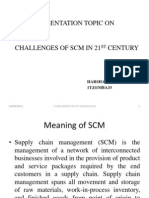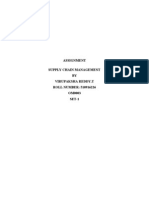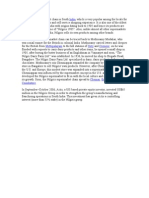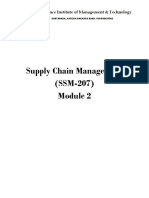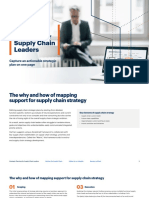Unit 3 Note
Unit 3 Note
Uploaded by
Ravi GuptaCopyright:
Available Formats
Unit 3 Note
Unit 3 Note
Uploaded by
Ravi GuptaOriginal Description:
Original Title
Copyright
Available Formats
Share this document
Did you find this document useful?
Is this content inappropriate?
Copyright:
Available Formats
Unit 3 Note
Unit 3 Note
Uploaded by
Ravi GuptaCopyright:
Available Formats
Unit 3 Supply Chain Management
In the context of SCM, we will view all these activities as a
sequence of processes within and between different supply chain
stages, which combine to fill a customer need for a product.
There are two different ways to view the processes performed in a
supply chain:
1. The cycle view -- this view focuses on the process cycles
of the products (or services) to be delivered to customers
starting from the raw material stage and ending with end
products. The cycle view divides the whole supply chain into
four process cycles, namely:
o
procurement cycle;
manufacturing cycle;
replenishment cycle; and
customer order cycle.
2. The push/pull view -- this view focuses on the division of
the supply chain processes according to customer demand.
The push processes are initiated according to demand
speculation and the pull processes are initiated according to
real customer demand. The push/pull view allows supply
chain managers to analyse supply chain activities from a
global view, which leads to higher-level strategic decisions.
Evolution of supply chain management
Even though SCM is not just logistic planning and inventory control,
the development of modern SCM was triggered by needs in logistic
planning and inventory control.
The early development of SCM can probably be traced back to the
quick response program in the textile industry and efficient
consumer response (ECR) in the grocery industry in the US
The need for supply chain management
The need for supply chain management is basically driven by
changes in the business and industrial environment. During the
past few decades, there has been an evolution in competitiveness
for many industries and businesses. The competition turned to
manufacturing and business process efficiency. The success of
companies relied on techniques and practices such as lean
manufacturing, just-in-time production, and stockless production.
Companies had to seek other opportunities outside in order to
compete. Issues such as the following needed to be addressed:
Where should we source materials?
Where should we manufacture?
What distribution channels should we use?
How can we build a good relationship with business partners
and customers?
How can we obtain effective market information?
What is the most efficient logistics structure?
How can we coordinate information flows globally?
Supply chain strategy
It is clear from the last section that SCM is vital to a company's
success in today's competitive and globalized business
environment. To embark on SCM and to increase the chance of
success, a company must align its supply chain objectives with its
overall business strategy.
Managing the supply chain means managing across functional areas
in the company as well as managing interactions external to the
company with business partners. This cross-boundary nature of
SCM requires top-down support from the senior management of the
company to incorporate supply chain goals and capabilities in the
strategic plan of the company. This focus on integration can lead to
using the supply chain to obtain a sustainable competitive
advantage over the competitors
Supply chain performance measures
Over the last decade companies have put significant investment
into the reengineering of their supply chain in order to compete.
They have sought to implement integrated supply chain
management through changes in business processes and
technology, which involve substantial financial and human
resources. Given this investment, senior management has to think
about how to develop an appropriate system of measurement to
track the benefits resulting from SCM implementation and to
provide guidance to the company for continuous improvement in
order to respond to the rapid changes in the business environment.
One common practice for measuring the performance of any
business process is to base it on financial return. However, it is
problematic to totally rely on financial return as the measure of
performance for complicated business processes such as an
integrated SCM for the following reasons:
Measurement based on financial return tends to be
historically oriented and lack a forward-looking perspective,
and hence fails to provide guidance for future improvement.
Such measurement does not relate directly to strategic
performance. For example, a start-up company may set
market share as its strategic SCM objective, but financial
return may not accurately reflect performance in this
regard.
This kind of measurement may not directly tie to operational
effectiveness and efficiency given such a complicated
system involving cross-functional processes internally and
business partners externally. For example, financial return
may be good in a favourable economic atmosphere despite
an inefficient and non-effective supply chain.
In recent years, a new approach to performance measurement,
called the 'balanced scorecard' approach, has been adopted to
assess corporate performance.
Inventory management
Managing economies of scale in a supply chain
To control the inventory of a product, we have to decide how much
of the product to order and how frequently. Traditionally, this
problem has been formulated as a decision problem. Mathematical
models have been developed to help determine the optimal order
quantity based on some simplified assumptions. These have been
further developed and extended into many complex and
sophisticated models. Using these models generally requires the
following information:
the inventory on hand and on order;
forecast of demand;
lead times of order delivery; and
estimates of inventory costs.
The inventory costs can be divided into the following components:
holding or carrying costs -- cost of storage, capital and
obsolescence/shrinkage;
setup or order costs -- costs associated with the production
of a lot internally or the placing of an order externally with a
vendor;
shortage or out-of-stock costs -- loss of profit and any 'illwill' generated; and
purchased material costs.
You can realize why inventory management is so important,
because inefficiency in any area breaks the supply chain and results
in a degradation of performance. For a complex supply chain, the
management of inventory will be much more difficult. Since
demand is uncertain in most situations, it is very difficult to
determine how much to order so that customer needs can be
fulfilled at minimal cost.
There are different approaches to manage each type of inventory. A
major distinction in the way different kinds of inventory are
managed results from the nature of demand.
Basically, demand can be divided into two categories: dependent
and independent demand.
Dependent demand derives from plans to make certain products,
e.g., raw materials, parts and assemblies.
Independent demand is normally for finished goods, and the
demand is mainly determined by some entity outside the producing
organization, e.g., customers. Referring to Figure 3.1, the raw
material and WIP inventories are subject to dependent demand and
the finished goods are subject to independent demand.
Dependent demand tends to be sporadic or 'lumpy' (i.e., large
quantities will be needed of a specific item, with little or no use of
that item at other times) because it is generated from the need for
some other items.
Independent demand is continuous although it may vary from
time to time. For this reason, we can actually predict the need for
dependent-demand items but not independent-demand items.
Dependent-demand items need only be stocked just prior to the
time they will be needed in the production process but
independent-demand items must be carried on a continued basis.
Managing uncertainty in a supply chain
In the inventory model, the re-order level is set such that a
replenishment order will arrive when the inventory level drops to
zero. This is an ideal situation because it assumes the product has
a constant demand.
In reality, the demand will vary and if the demand exceeds the
expectation during the lead time, an out-of-stock situation will
occur and seriously affect customer service as well as profit.
To avoid being out-of-stock, a certain amount of safety inventory
will be kept in the system to satisfy an unexpectedly high demand
during the lead time. The safety inventory will act as a buffer for
serving customers.
The appropriate level of safety inventory is determined by two
factors: the uncertainty of demand and the desired level of product
availability (or service level). The safety inventory level can be
derived from these two factors statistically. Now, read the textbook
to study how the safety inventory can be derived for the case with
or without fixed ordering costs.
Practical issues
To be effective, the inventory management system must include:
a system to keep track of the inventory on hand and on
order;
a reliable forecast of demand that includes an indication of
possible forecast error;
knowledge of lead time and its variability; and
reasonable estimates of inventory costs
Logistics network configuration and distribution
strategies
Transportation in a supply chain
Transportation deals with moving a product in a supply chain.
Transportation decisions can involve mode selection, shipment size,
routing and scheduling.
These decisions are influenced by many factors such as the
proximity of warehouses to customers or plants, the required level
of customer service, the size of the storage facility, etc.
Transportation also affects decisions in inventory management and
facility location in a supply chain. Therefore, it has a direct impact
on the responsiveness and efficiency of the supply chain. The
success of any supply chain, particularly a global one, is closely
linked to the appropriate use of transportation.
Distribution strategies
The design of a transportation network directly affects the
performance of a supply chain. Chopra and Meindl (2001)
suggested the following five alternative design options for
transportation networks to take advantage of three outbound
distribution strategies.
Direct shipment network (Figure 3.2) -- all shipments come
directly from suppliers to the retail store.
Direct shipment with milk runs (Figure 3.3) -- a supplier
delivers directly to multiple retail stores on a truck by a milk
run.
All shipments via a central distribution center (Figure 3.4) -all shipments are delivered to a central distribution center
(DC) to breakbulk, crossduck (or mix), or consolidate into
many smaller shipments for delivery to retail stores.
Shipping via a distribution center using milk runs (Figure
3.5) -- this is similar to the previous method, except milk
runs are used for delivery from the DC to retail stores to
reduce outbound traffic.
Tailored network -- a network specifically designed to meet
the transportation requirements of an organization using a
combination of crossducking, milk runs, etc
Network design in a supply chain
Network design is a complex decision problem. To find solutions,
you normally have to go through the following steps:
1. define the problem
2. collect the data
3. formulate the model and validate the data
4. solve the problem.
Logistics problems usually deal with a decision that balances the
cost of allocation of resources (e.g., a warehouse) against the level
of customer service. The following reading from the textbook
describes a typical scenario of how to define the network design
problem.
Network design is a complex decision problem. To find
solutions, you normally have to go through the following steps:
1. define the problem
2. collect the data
3. formulate the model and validate the data
4. solve the problem.
Logistics problems usually deal with a decision that balances the
cost of allocation of resources (e.g., a warehouse) against the level
of customer service. The following reading from the textbook
describes a typical scenario of how to define the network design
problem.
You might also like
- GSL Study Guide 3rd Edition For 2022 Semester 1100% (2)GSL Study Guide 3rd Edition For 2022 Semester 1598 pages
- Logistic and Supply Chain Managment Assessment - NG-OTHM-DLSCM-05-14No ratings yetLogistic and Supply Chain Managment Assessment - NG-OTHM-DLSCM-05-1452 pages
- Introduction To Retail Management Module 1100% (1)Introduction To Retail Management Module 152 pages
- 10 - Introduction To Global Supply ChainNo ratings yet10 - Introduction To Global Supply Chain29 pages
- Assignment Supply Chain Management BY Virupaksha Reddy.T ROLL NUMBER: 510916226 OM0003 SET-1No ratings yetAssignment Supply Chain Management BY Virupaksha Reddy.T ROLL NUMBER: 510916226 OM0003 SET-112 pages
- Nilgiris Is A Supermarket Chain in South India, Which IsNo ratings yetNilgiris Is A Supermarket Chain in South India, Which Is2 pages
- Abhi - Introduction Scope and Historical Background of SCM100% (1)Abhi - Introduction Scope and Historical Background of SCM22 pages
- Chapter 1 - Understanding The Supply ChainNo ratings yetChapter 1 - Understanding The Supply Chain29 pages
- ITC Chaupal Bazaar Tata Kisan Sansaar Hariyali Kisan Bazaar Godrej Aadhaar 3A BazaarNo ratings yetITC Chaupal Bazaar Tata Kisan Sansaar Hariyali Kisan Bazaar Godrej Aadhaar 3A Bazaar34 pages
- Survey Questionnaire: Impact of Reputational Risk Management On Sustainable Performance of Small and Medium EnterpriseNo ratings yetSurvey Questionnaire: Impact of Reputational Risk Management On Sustainable Performance of Small and Medium Enterprise3 pages
- Assignment On International Logistics Mangement 2No ratings yetAssignment On International Logistics Mangement 26 pages
- Unit 5-Warehousing, Handling and Picking System100% (1)Unit 5-Warehousing, Handling and Picking System50 pages
- Chapter 1 - Introduction To Global LogisticsNo ratings yetChapter 1 - Introduction To Global Logistics34 pages
- Answers To Question Number 2: Push and Pull Supply ChainNo ratings yetAnswers To Question Number 2: Push and Pull Supply Chain4 pages
- Chapter 2 - Supply Chain Performance: Achieving Strategic Fit and ScopeNo ratings yetChapter 2 - Supply Chain Performance: Achieving Strategic Fit and Scope2 pages
- Session 05-Supply Chain Coordination and Use of TechnologyNo ratings yetSession 05-Supply Chain Coordination and Use of Technology12 pages
- The Impact of Supply Chain Management Practices On Organizational Performance of Textile IndustryNo ratings yetThe Impact of Supply Chain Management Practices On Organizational Performance of Textile Industry66 pages
- Inventory Management at Shreem Electric LTD.: Submited To: Neha Ma'am75% (4)Inventory Management at Shreem Electric LTD.: Submited To: Neha Ma'am18 pages
- Supplier Customer Raw Materials Value ChainsNo ratings yetSupplier Customer Raw Materials Value Chains44 pages
- Global Supply Chain Management Notes-Msc Procurement and Logistics-Sept, 2023No ratings yetGlobal Supply Chain Management Notes-Msc Procurement and Logistics-Sept, 202385 pages
- Lectura Planeacion de La Demanda - para Los EstudiantesNo ratings yetLectura Planeacion de La Demanda - para Los Estudiantes17 pages
- Assembly Line Balancing Problem With Reduced Number of WorkstationsNo ratings yetAssembly Line Balancing Problem With Reduced Number of Workstations6 pages
- Advertising of Controversial Products: A Cross-Cultural StudyNo ratings yetAdvertising of Controversial Products: A Cross-Cultural Study8 pages
- Do Ethical Preferences Differ Depending On The Type of ProductNo ratings yetDo Ethical Preferences Differ Depending On The Type of Product18 pages
- Business Policy & Straegic Analysis (Cp-301)No ratings yetBusiness Policy & Straegic Analysis (Cp-301)41 pages
- What Is Corporate Social Responsibility?No ratings yetWhat Is Corporate Social Responsibility?22 pages
- Part 5-Looking To The Future Chapter 16-Supply Chain Process Integration and A Look Towards The FutureNo ratings yetPart 5-Looking To The Future Chapter 16-Supply Chain Process Integration and A Look Towards The Future73 pages
- What Is Corporate Social Responsibility?No ratings yetWhat Is Corporate Social Responsibility?10 pages
- Strategic Planning Is An Organization's Process of Defining Its Strategy, or Direction, and MakingNo ratings yetStrategic Planning Is An Organization's Process of Defining Its Strategy, or Direction, and Making3 pages
- Icar-Indian Institute of Pulses Research Kalyanpur, Kanpur - 208 024 (An ISO 9001:2008 Certified Institute)No ratings yetIcar-Indian Institute of Pulses Research Kalyanpur, Kanpur - 208 024 (An ISO 9001:2008 Certified Institute)4 pages
- Minimum Criteria For Different PositionsNo ratings yetMinimum Criteria For Different Positions2 pages
- CMEC 1 Course Major Requirments Strategic GuidesNo ratings yetCMEC 1 Course Major Requirments Strategic Guides6 pages
- Future of Corporate Communications - FINAL - FULL - REPORTNo ratings yetFuture of Corporate Communications - FINAL - FULL - REPORT76 pages
- Compare These Models To The Business Plan Models in Microsoft Project100% (1)Compare These Models To The Business Plan Models in Microsoft Project8 pages
- Strategic Planning For Supply Chain Leaders: Capture An Actionable Strategic Plan On One PageNo ratings yetStrategic Planning For Supply Chain Leaders: Capture An Actionable Strategic Plan On One Page7 pages
- A General Model of Software Architecture Design Derived From Five Industrial ApproachesNo ratings yetA General Model of Software Architecture Design Derived From Five Industrial Approaches21 pages
- 2 - The Evolving Role of Information Systems and Technolo100% (1)2 - The Evolving Role of Information Systems and Technolo57 pages
- Hon. Mayor Silvestre T. Lumarda of Inopacan, Leyte, Philippines100% (1)Hon. Mayor Silvestre T. Lumarda of Inopacan, Leyte, Philippines18 pages
- Devesh Summer Training Report 40296788815No ratings yetDevesh Summer Training Report 4029678881561 pages
- Sbi Customers Perception On CRM: A Study: M. Malla Reddy A. SureshNo ratings yetSbi Customers Perception On CRM: A Study: M. Malla Reddy A. Suresh11 pages
- Computerized Maintenance Management Information System (CMMIS) in Support of Planning, Scheduling, and CoordinationNo ratings yetComputerized Maintenance Management Information System (CMMIS) in Support of Planning, Scheduling, and Coordination3 pages
- PWC Kenya Graduate Recruitment 2012 BrochureNo ratings yetPWC Kenya Graduate Recruitment 2012 Brochure28 pages
- Chapter 2 Strategic Planning and Marketing ProcessNo ratings yetChapter 2 Strategic Planning and Marketing Process6 pages
- 2015 KMPG - Transforming A Procurement OrganizationNo ratings yet2015 KMPG - Transforming A Procurement Organization28 pages
- Director Human Resources Business Partner in Washington DC ST Louis MO Resume Ann SherrillNo ratings yetDirector Human Resources Business Partner in Washington DC ST Louis MO Resume Ann Sherrill4 pages
- Logistic and Supply Chain Managment Assessment - NG-OTHM-DLSCM-05-14Logistic and Supply Chain Managment Assessment - NG-OTHM-DLSCM-05-14
- Assignment Supply Chain Management BY Virupaksha Reddy.T ROLL NUMBER: 510916226 OM0003 SET-1Assignment Supply Chain Management BY Virupaksha Reddy.T ROLL NUMBER: 510916226 OM0003 SET-1
- Nilgiris Is A Supermarket Chain in South India, Which IsNilgiris Is A Supermarket Chain in South India, Which Is
- Abhi - Introduction Scope and Historical Background of SCMAbhi - Introduction Scope and Historical Background of SCM
- ITC Chaupal Bazaar Tata Kisan Sansaar Hariyali Kisan Bazaar Godrej Aadhaar 3A BazaarITC Chaupal Bazaar Tata Kisan Sansaar Hariyali Kisan Bazaar Godrej Aadhaar 3A Bazaar
- Survey Questionnaire: Impact of Reputational Risk Management On Sustainable Performance of Small and Medium EnterpriseSurvey Questionnaire: Impact of Reputational Risk Management On Sustainable Performance of Small and Medium Enterprise
- Answers To Question Number 2: Push and Pull Supply ChainAnswers To Question Number 2: Push and Pull Supply Chain
- Chapter 2 - Supply Chain Performance: Achieving Strategic Fit and ScopeChapter 2 - Supply Chain Performance: Achieving Strategic Fit and Scope
- Session 05-Supply Chain Coordination and Use of TechnologySession 05-Supply Chain Coordination and Use of Technology
- The Impact of Supply Chain Management Practices On Organizational Performance of Textile IndustryThe Impact of Supply Chain Management Practices On Organizational Performance of Textile Industry
- Inventory Management at Shreem Electric LTD.: Submited To: Neha Ma'amInventory Management at Shreem Electric LTD.: Submited To: Neha Ma'am
- Inventory valuation Complete Self-Assessment GuideFrom EverandInventory valuation Complete Self-Assessment Guide
- Global Supply Chain Management Notes-Msc Procurement and Logistics-Sept, 2023Global Supply Chain Management Notes-Msc Procurement and Logistics-Sept, 2023
- Lectura Planeacion de La Demanda - para Los EstudiantesLectura Planeacion de La Demanda - para Los Estudiantes
- Assembly Line Balancing Problem With Reduced Number of WorkstationsAssembly Line Balancing Problem With Reduced Number of Workstations
- Advertising of Controversial Products: A Cross-Cultural StudyAdvertising of Controversial Products: A Cross-Cultural Study
- Do Ethical Preferences Differ Depending On The Type of ProductDo Ethical Preferences Differ Depending On The Type of Product
- Part 5-Looking To The Future Chapter 16-Supply Chain Process Integration and A Look Towards The FuturePart 5-Looking To The Future Chapter 16-Supply Chain Process Integration and A Look Towards The Future
- Strategic Planning Is An Organization's Process of Defining Its Strategy, or Direction, and MakingStrategic Planning Is An Organization's Process of Defining Its Strategy, or Direction, and Making
- Icar-Indian Institute of Pulses Research Kalyanpur, Kanpur - 208 024 (An ISO 9001:2008 Certified Institute)Icar-Indian Institute of Pulses Research Kalyanpur, Kanpur - 208 024 (An ISO 9001:2008 Certified Institute)
- Future of Corporate Communications - FINAL - FULL - REPORTFuture of Corporate Communications - FINAL - FULL - REPORT
- Compare These Models To The Business Plan Models in Microsoft ProjectCompare These Models To The Business Plan Models in Microsoft Project
- Strategic Planning For Supply Chain Leaders: Capture An Actionable Strategic Plan On One PageStrategic Planning For Supply Chain Leaders: Capture An Actionable Strategic Plan On One Page
- A General Model of Software Architecture Design Derived From Five Industrial ApproachesA General Model of Software Architecture Design Derived From Five Industrial Approaches
- 2 - The Evolving Role of Information Systems and Technolo2 - The Evolving Role of Information Systems and Technolo
- Hon. Mayor Silvestre T. Lumarda of Inopacan, Leyte, PhilippinesHon. Mayor Silvestre T. Lumarda of Inopacan, Leyte, Philippines
- Sbi Customers Perception On CRM: A Study: M. Malla Reddy A. SureshSbi Customers Perception On CRM: A Study: M. Malla Reddy A. Suresh
- Computerized Maintenance Management Information System (CMMIS) in Support of Planning, Scheduling, and CoordinationComputerized Maintenance Management Information System (CMMIS) in Support of Planning, Scheduling, and Coordination
- Chapter 2 Strategic Planning and Marketing ProcessChapter 2 Strategic Planning and Marketing Process
- 2015 KMPG - Transforming A Procurement Organization2015 KMPG - Transforming A Procurement Organization
- Director Human Resources Business Partner in Washington DC ST Louis MO Resume Ann SherrillDirector Human Resources Business Partner in Washington DC ST Louis MO Resume Ann Sherrill









